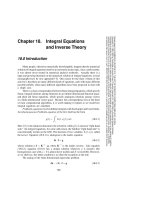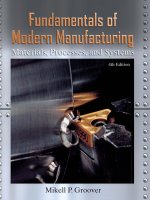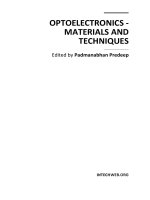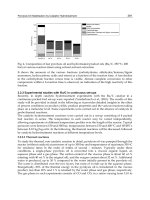Composites Manufacturing - Materials, Product, and Process Engineering Part 1 pptx
Bạn đang xem bản rút gọn của tài liệu. Xem và tải ngay bản đầy đủ của tài liệu tại đây (295.62 KB, 20 trang )
COMPOSITES
MANUFACTURING
Materials, Product,
and Process Engineering
© 2002 by CRC Press LLC
CRC PRESS
Boca Raton London New York Washington, D.C.
COMPOSITES
MANUFACTURING
Materials, Product,
and Process Engineering
Sanjay K. Mazumdar, Ph.D.
This book contains information obtained from authentic and highly regarded sources. Reprinted material
is quoted with permission, and sources are indicated. A wide variety of references are listed. Reasonable
efforts have been made to publish reliable data and information, but the author and the publisher cannot
assume responsibility for the validity of all materials or for the consequences of their use.
Neither this book nor any part may be reproduced or transmitted in any form or by any means, electronic
or mechanical, including photocopying, microfilming, and recording, or by any information storage or
retrieval system, without prior permission in writing from the publisher.
The consent of CRC Press LLC does not extend to copying for general distribution, for promotion, for
creating new works, or for resale. Specific permission must be obtained in writing from CRC Press LLC
for such copying.
Direct all inquiries to CRC Press LLC, 2000 N.W. Corporate Blvd., Boca Raton, Florida 33431.
Trademark Notice:
Product or corporate names may be trademarks or registered trademarks, and are
used only for identification and explanation, without intent to infringe.
Visit the CRC Press Web site at www.crcpress.com
© 2002 by CRC Press LLC
No claim to original U.S. Government works
International Standard Book Number 0-8493-0585-3
Library of Congress Card Number 2001004994
Printed in the United States of America 1 2 3 4 5 6 7 8 9 0
Printed on acid-free paper
Library of Congress Cataloging-in-Publication Data
Mazumdar, Sanjay K.
Composites manufacturing : materials, product, and process
engineering / by Sandjay K. Mazumdar.
p. cm.
Includes bibliographical references and index.
ISBN 0-8493-0585-3
1. Composite materials.
TA418.9.C6 M34 2001
620.1
¢
18 dc21 2001004994
© 2002 by CRC Press LLC
Surrendered to the Lord of the Universe
© 2002 by CRC Press LLC
Preface
Early large-scale commercial applications of composite materials started
during World War II (late 1940s and early 1950s) with marine applications
for the military; but today, composite products are manufactured by a diverse
range of industries, including aerospace, automotive, marine, boating, sport-
ing goods, consumer, infrastructure, and more. In recent years, the develop-
ment of new and improved composites manufacturing processes has caused
unlimited product development opportunities. New high-volume produc-
tion methods such as compression molding (SMC) reveal a gained maturity
level and are routinely used for making automotive, consumer, and indus-
trial parts with a good confidence level. The use of composite materials is
no longer limited to only naval and spacecraft applications. New material
innovations, and a drop in pricing and development of improved manufac-
turing processes have given rise to the presence of composite materials in
almost every industrial sector. In fact, because of styling detail possibilities
and the high surface finish quality attainable by composites fabrication pro-
cesses, composites are considered materials of choice for certain industry
sectors (e.g., automotive).
Until recently, only a few universities offered courses on composites man-
ufacturing, probably due to the lack of a suitable textbook. This book offers
all the related materials to make composites manufacturing a part of the
curriculum in the composite materials discipline. This book covers important
aspects of composites product manufacturing, such as product manufactur-
ability, product development, processing science, manufacturing processes,
cost estimating, and more. These aspects of fabrication issues, which are
crucial in the production of good composite parts, have not been covered in
any of the books available in the composites industry. The most common
courses offered at universities in the composite materials field are related to
the introduction and design aspects of composite materials. Without pro-
cessing and product development knowledge, successful composite prod-
ucts cannot be fabricated. This book bridges this gap and covers important
elements of product manufacturing using composite materials. This book is
suitable for students, engineers, and researchers working in the composite
materials field. This book offers valuable insight into the production of cost-
competitive and high-quality composite parts. Engineers and professionals
working in the composites industry can significantly benefit from the content
of this book.
This book discusses the subject of manufacturing within the framework
of the fundamental classification of processes. This should help the reader
understand where a particular manufacturing process fits within the overall
© 2002 by CRC Press LLC
fabrication scheme and what processes might be suitable for the manufacture
of a particular component. The subject matters are adequately descriptive
for those unfamiliar with the various fabrication techniques and yet suffi-
ciently analytical for an academic course in composites manufacturing.
The book takes the reader step-by-step from raw material selection to final
part fabrication and recycling. Chapter 2 details the raw materials available
in the composites industry for the fabrication of various composite products.
Methods of selecting the correct material from the thousands of materials
available are discussed in Chapter 3. Chapter 4 discusses the six important
phases of the product development process. It provides roadmaps to engi-
neers and team members for the activities and deliverables required for the
design, development, and fabrication of the part. Chapter 5 describes pro-
cedures to design a product, taking manufacturing into consideration. To be
competitive in the current global marketplace, products must be designed
in a minimum amount of time and with minimum resources and cost. Design
for manufacturing (DFM) plays a key role in concept generation, concept
approval, and concept improvement, and comes up with a better design in
the shortest time. It integrates processing knowledge into the design of a
part to get the maximum benefit and capabilities from the manufacturing
method. As compared to metals, composite materials offer the higher poten-
tial of utilizing DFM and part integration, and therefore can significantly
reduce the cost of production. Chapter 6 discusses various composite man-
ufacturing techniques in terms of their advantages, disadvantages, raw mate-
rials requirements, applications, tooling and mold requirements, methods of
applying heat and pressure, processing steps, and more. Process selection
criteria and basic steps in composite manufacturing processes are discussed
in this chapter. Process models for key manufacturing processes are
described in Chapter 7. Process models are used to determine optimum
processing conditions for making good-quality composite parts. This elimi-
nates processing problems before a manufacturing process begins or before
the part design is finalized. Preproduction guidelines and methods of writing
manufacturing instructions and bill of materials are discussed in Chapter 8.
Joining and machining of composite parts require a different approach than
the joining and machining of metal parts; these are discussed in Chapters 9
and 10, respectively. Cost-estimating techniques are elaborated in Chapter 11.
Tools for selecting a best technology/fabrication process to get a competitive
advantage in the marketplace are included in this chapter. Finally, recycling
aspects of composite materials, which are becoming growing concerns in
industry and government sectors, are discussed in Chapter 12. Overall, this
book provides professionals with valuable information related to composites
product manufacturing as well as best state-of-the-art knowledge in this
field.
© 2002 by CRC Press LLC
Acknowledgments
With great devotion I acknowledge the grace of God for the successful
completion of this book.
I am grateful to all the engineers, researchers, scientists, and professionals
who contributed to the development of composites manufacturing processes
and technologies. With their efforts, composites technology has gained matu-
rity and has been used confidently for various applications. I am thankful
to Professor Timothy Gutowski (M.I.T.), Gerald Sutton (Intellitec), John
Marks (COI Materials), and John Taylor (Goodrich Corp.) for reviewing this
book and for providing excellent comments.
I am thankful to my friends and relatives for their kindness and support.
I am grateful to my wife Gargi Mazumdar for her patience and support
during the writing of this book. Thanks to my 6-year-old daughter Ria
Mazumdar for letting me work on my book. And I am thankful to my parents
for their love and support.
© 2002 by CRC Press LLC
Author
Dr. Sanjay K. Mazumdar
is president and CEO of E-Composites.com, Inc.,
Grandville, Michigan, U.S.A., a leading service-oriented company providing
market reports, job bank services,
CompositesWeek
newsletter, CompositesEx-
change for buy and sell trades, product marketing, product commercializa-
tion, and various other services for the composite materials industry. E-
Composites.com, Inc. provides various platforms for connecting buyers to
sellers, vendors to customers, employers to employees, and technical pro-
fessionals to a wealth of information. E-Composites.com, Inc. is dedicated
to rapid development of the composite materials industry and connects more
than 20,000 composite users and suppliers from more than 50 countries using
its weekly newsletter and Web site. E-Composites.com, Inc.’s clients range
from small to Fortune 500 companies such as AOC, BFGoodrich, Bayer Corp.,
Dow Corning, General Electric, Hexcel, Johns Manville, Lockheed Martin,
Owens Corning, Saint-Gobain, Zeon Chemical, and many more.
Dr. Mazumdar has published more than 25 professional papers on pro-
cessing, joining, and testing of composite materials in reputed international
journals and conference proceedings. He has designed and developed more
than 100 composite products for a variety of applications, including auto-
motive, aerospace, electronic, consumer, and industrial applications. He has
two Society of Plastics Engineers (SPE) awards and two General Motors’
Record of Innovation awards for his creativity and innovations. He has
worked as adjunct faculty at the University of Michigan, Dearborn, and
Concordia University, Montreal, and has taught composite materials-related
courses to undergraduate and graduate students. He has given seminars and
presentations at international conferences and reputed universities, includ-
ing the University of California, Berkeley, and Fortune 500 companies.
Dr. Mazumdar can be contacted by e-mail at
or
visit the Web site — www.e-composites.com — for details.
© 2002 by CRC Press LLC
Contents
1
Introduction
1.1 Conventional Engineering Materials
1.1.1 Metals
1.1.2 Plastics
1.1.3 Ceramics
1.1.4 Composites
1.2 What Are Composites?
1.3 Functions of Fibers and Matrix
1.4 Special Features of Composites
1.5 Drawbacks of Composites
1.6 Composites Processing
1.7 Composites Product Fabrication
1.8 Composites Markets
1.8.1 The Aerospace Industry
1.8.2 The Automotive Industry
1.8.3 The Sporting Goods Industry
1.8.4 Marine Applications
1.8.5 Consumer Goods
1.8.6 Construction and Civil Structures
1.8.7 Industrial Applications
1.9 Barriers in Composite Markets
References
Questions
2
Raw Materials for Part Fabrication
2.1 Introduction
2.2 Reinforcements
2.2.1 Glass Fiber Manufacturing
2.2.2 Carbon Fiber Manufacturing
2.2.3 Aramid Fiber Manufacturing
2.3 Matrix Materials
2.3.1 Thermoset Resins
2.3.1.1 Epoxy
2.3.1.2 Phenolics
2.3.1.3 Polyesters
2.3.1.4 Vinylesters
2.3.1.5 Cyanate Esters
2.3.1.6 Bismaleimide (BMI) and Polyimide
2.3.1.7 Polyurethane
© 2002 by CRC Press LLC
2.3.2 Thermoplastic Resins
2.3.2.1 Nylons
2.3.2.2 Polypropylene (PP)
2.3.2.3 Polyetheretherketone (PEEK)
2.3.2.4 Polyphenylene Sulfide (PPS)
2.4 Fabrics
2.4.1 Woven Fabrics
2.4.2 Noncrimp Fabrics
2.5 Prepregs
2.5.1 Thermoset Prepregs
2.5.2 Thermoplastic Prepregs
2.6 Preforms
2.7 Molding Compound
2.7.1 Sheet Molding Compound
2.7.2 Thick Molding Compound (TMC)
2.7.3 Bulk Molding Compound (BMC)
2.7.4 Injection Moldable Compounds
2.8 Honeycomb and Other Core Materials
References
Questions
3
Material Selection Guidelines
3.1 Introduction
3.2 The Need for Material Selection
3.3 Reasons for Material Selection
3.4 Material Property Information
3.5 Steps in the Material Selection Process
3.5.1 Understanding and Determining the Requirements
3.5.2 Selection of Possible Materials
3.5.3 Determination of Candidate Materials
3.5.4 Testing and Evaluation
3.6 Material Selection Methods
3.6.1 Cost vs. Property Analysis
3.6.2 Weighted Property Comparison Method
3.6.2.1 Scaling for Maximum Property Requirement
3.6.2.2 Scaling for Minimum Property Requirement
3.6.2.3 Scaling for Nonquantitative Property
3.6.3 Expert System for Material Selection
Bibliography
Questions
4
Product Development
4.1 Introduction
4.2 What Is the Product Development Process
4.3 Reasons for Product Development
4.4 Importance of Product Development
© 2002 by CRC Press LLC
4.5 Concurrent Engineering
4.6 Product Life Cycle
4.7 Phases of Product Development
4.7.1 Concept Feasibility Phase
4.7.2 Detailed Design Phase
4.7.3 Prototype Development and Testing Phase
4.7.4 Preproduction Demonstration, or Pilot-Scale Production
4.7.5 Full-Scale Production and Distribution
4.7.6 Continuous Improvement
4.8 Design Review
4.9 Failure Modes and Effects Analysis (FMEA)
Reference
Bibiliography
Questions
5
Design for Manufacturing
5.1 Introduction
5.2 Design Problems
5.3 What Is DFM?
5.4 DFM Implementation Guidelines
5.4.1 Minimize Part Counts
5.4.2 Eliminate Threaded Fasteners
5.4.3 Minimize Variations
5.4.4 Easy Serviceability and Maintainability
5.4.5 Minimize Assembly Directions
5.4.6 Provide Easy Insertion and Alignment
5.4.7 Consider Ease for Handling
5.4.8 Design for Multifunctionality
5.4.9 Design for Ease of Fabrication
5.4.10 Prefer Modular Design
5.5 Success Stories
5.5.1 Composite Pickup Box
5.5.2 Laser Printer
5.5.3 Black & Decker Products
5.6 When to Apply DFM
5.7 Design Evaluation Method
5.8 Design for Assembly (DFA)
5.8.1 Benefits of DFA
5.8.2 Assembly-Related Defects
5.8.3 Guidelines for Minimizing Assembly Defects
References
Questions
6
Manufacturing Techniques
6.1 Introduction
© 2002 by CRC Press LLC
6.2 Manufacturing Process Selection Criteria
6.2.1 Production Rate/Speed
6.2.2 Cost
6.2.3 Performance
6.2.4 Size
6.2.5 Shape
6.3 Product Fabrication Needs
6.4 Mold and Tool Making
6.4.1 Mold Design Criteria
6.4.1.1 Shrinkage Allowance
6.4.1.2 Coefficient of Thermal Expansion of Tool
Material and End Product
6.4.1.3 Stiffness of the Mold
6.4.1.4 Surface Finish Quality
6.4.1.5 Draft and Corner Radii
6.4.2 Methods of Making Tools
6.4.2.1 Machining
6.4.2.2 FRP Tooling for Open Molding Processes
6.4.3 Tooling Guidelines for Closed Molding Operations
6.5 Basic Steps in a Composites Manufacturing Process
6.5.1 Impregnation
6.5.2 Lay-up
6.5.3 Consolidation
6.5.4 Solidification
6.6 Advantages and Disadvantages of Thermoset
and Thermoplastic Composites Processing
6.6.1 Advantages of Thermoset Composites Processing
6.6.2 Disadvantages of Thermoset Composites Processing
6.6.3 Advantages of Thermoplastic Composites Processing
6.6.4 Disadvantages of Thermoplastic Composites Processing
6.7 Composites Manufacturing Processes
6.8 Manufacturing Processes for Thermoset Composites
6.8.1 Prepreg Lay-Up Process
6.8.1.1 Major Applications
6.8.1.2 Basic Raw Materials
6.8.1.3 Tooling Requirements
6.8.1.4 Making of the Part
6.8.1.5 Methods of Applying Heat and Pressure
6.8.1.6 Basic Processing Steps
6.8.1.7 Typical Manufacturing Challenges
6.8.1.8 Advantages of the Prepreg Lay-Up Process
6.8.1.9 Limitations of the Prepreg Lay-Up Process
6.8.2 Wet Lay-Up Process
6.8.2.1 Major Applications
6.8.2.2 Basic Raw Materials
6.8.2.3 Tooling Requirements
© 2002 by CRC Press LLC
6.8.2.4 Making of the Part
6.8.2.5 Methods of Applying Heat and Pressure
6.8.2.6 Basic Processing Steps
6.8.2.7 Advantages of the Wet Lay-Up Process
6.8.2.8 Limitations of the Wet Lay-Up Process
6.8.3 Spray-Up Process
6.8.3.1 Major Applications
6.8.3.2 Basic Raw Materials
6.8.3.3 Tooling Requirements
6.8.3.4 Making of the Part
6.8.3.5 Methods of Applying Heat and Pressure
6.8.3.6 Basic Processing Steps
6.8.3.7 Advantages of the Spray-Up Process
6.8.3.8 Limitations of the Spray-Up Process
6.8.4 Filament Winding Process
6.8.4.1 Major Applications
6.8.4.2 Basic Raw Materials
6.8.4.3 Tooling
6.8.4.4 Making of the Part
6.8.4.5 Methods of Applying Heat and Pressure
6.8.4.6 Methods of Generating the Desired Winding
Angle
6.8.4.7 Basic Processing Steps
6.8.4.8 Advantages of the Filament Winding Process
6.8.4.9 Limitations of the Filament Winding Process
6.8.5 Pultrusion Process
6.8.5.1 Major Applications
6.8.5.2 Basic Raw Materials
6.8.5.3 Tooling
6.8.5.4 Making of the Part
6.8.5.4.1 Wall Thickness
6.8.5.4.2 Corner Design
6.8.5.4.3 Tolerances, Flatness, and Straightness
6.8.5.4.4 Surface Texture
6.8.5.5 Methods of Applying Heat and Pressure
6.8.5.6 Basic Processing Steps
6.8.5.7 Advantages of the Pultrusion Process
6.8.5.8 Limitations of the Pultrusion Process
6.8.6 Resin Transfer Molding Process
6.8.6.1 Major Applications
6.8.6.2 Basic Raw Materials
6.8.6.3 Tooling
6.8.6.4 Making of the Part
6.8.6.5 Methods of Applying Heat and Pressure
6.8.6.6 Basic Processing Steps
6.8.6.7 Advantages of the Resin Transfer Molding
Process
© 2002 by CRC Press LLC
6.8.6.8 Limitations of the Resin Transfer Molding
Process
6.8.6.9 Variations of the RTM Process
6.8.6.9.1 VARTM
6.8.6.9.2 SCRIMP
6.8.7 Structural Reaction Injection Molding (SRIM) Process
6.8.7.1 Major Applications
6.8.7.2 Basic Raw Materials
6.8.7.3 Tooling
6.8.7.4 Making of the Part
6.8.7.5 Methods of Applying Heat and Pressure
6.8.7.6 Basic Processing Steps
6.8.7.7 Advantages of the SRIM Process
6.8.7.8 Limitations of the SRIM Process
6.8.8 Compression Molding Process
6.8.8.1 Major Applications
6.8.8.2 Basic Raw Materials
6.8.8.3 Making of the Part
6.8.8.4 Mold Design
6.8.8.5 Methods of Applying Heat and Pressure
6.8.8.6 Basic Processing Steps
6.8.8.7 Advantages of the Compression Molding
Process
6.8.8.8 Limitations of the Compression Molding
Process
6.8.9 Roll Wrapping Process
6.8.9.1 Major Applications
6.8.9.2 Basic Raw Materials
6.8.9.3 Tooling
6.8.9.4 Making of the Part
6.8.9.5 Methods of Applying Heat and Pressure
6.8.9.6 Basic Processing Steps
6.8.9.7 Advantages of the Roll Wrapping Process
6.8.9.8 Limitations of the Roll Wrapping Process
6.8.9.9 Common Problems with the Roll Wrapping
Process
6.8.10 Injection Molding of Thermoset Composites
6.8.10.1 Major Applications
6.8.10.2 Basic Raw Materials
6.8.10.3 Tooling
6.8.10.4 Making of the Part
6.9 Manufacturing Processes for Thermoplastic Composites
6.9.1 Thermoplastic Tape Winding
6.9.1.1 Major Applications
6.9.1.2 Basic Raw Materials
6.9.1.3 Tooling
© 2002 by CRC Press LLC
6.9.1.4 Making of the Part
6.9.1.5 Methods of Applying Heat and Pressure
6.9.1.6 Advantages of the Thermoplastic Tape Winding
Process
6.9.1.7 Limitations of the Thermoplastic Tape Winding
Process
6.9.2 Thermoplastic Pultrusion Process
6.9.2.1 Major Applications
6.9.2.2 Basic Raw Materials
6.9.2.3 Tooling
6.9.2.4 Making of the Part
6.9.2.5 Methods of Applying Heat and Pressure
6.9.2.6 Advantages of the Thermoplastic Pultrusion
Process
6.9.2.7 Limitations of the Thermoplastic Pultrusion
Process
6.9.3 Compression Molding of GMT
6.9.3.1 Major Applications
6.9.3.2 Basic Raw Materials
6.9.3.3 Tooling
6.9.3.4 Part Fabrication
6.9.3.5 Methods of Applying Heat and Pressure
6.9.3.6 Advantages of Compression Molding of GMT
6.9.3.7 Limitations of Compression Molding of GMT
6.9.4 Hot Press Technique
6.9.4.1 Major Applications
6.9.4.2 Basic Raw Materials
6.9.4.3 Tooling
6.9.4.4 Making of the Part
6.9.4.5 Methods of Applying Heat and Pressure
6.9.4.6 Basic Processing Steps
6.9.4.7 Advantages of the Hot Press Technique
6.9.4.8 Limitations of the Hot Press Technique
6.9.5 Autoclave Processing
6.9.5.1 Major Applications
6.9.5.2 Basic Raw Materials
6.9.5.3 Tooling
6.9.5.4 Making the Part
6.9.5.5 Methods of Applying Heat and Pressure
6.9.5.6 Basic Processing Steps
6.9.5.7 Advantages of Autoclave Processing
6.9.5.8 Limitations of Autoclave Processing
6.9.6 Diaphragm Forming Process
6.9.6.1 Major Applications
6.9.6.2 Basic Raw Materials
6.9.6.3 Tooling
© 2002 by CRC Press LLC
6.9.6.4 Making of the Part
6.9.6.5 Methods of Applying Heat and Pressure
6.9.6.6 Advantages of the Diaphragm Forming Process
6.9.6.7 Limitations of the Diaphragm Forming Process
6.9.7 Injection Molding
6.9.7.1 Major Applications
6.9.7.2 Basic Raw Materials
6.9.7.3 Tooling
6.9.7.4 Making of the Part
6.9.7.5 Basic Processing Steps
6.9.7.6 Methods of Applying Heat and Pressure
6.9.7.7 Advantages of the Injection Molding Process
6.9.7.8 Limitations of the Injection Molding Process
References
Bibliography
Questions
7
Process Models
7.1 Introduction
7.2 The Importance of Models in Composites Manufacturing
7.3 Composites Processing
7.4 Process Models for Selected Thermosets and Thermoplastics
Processing
7.4.1 Thermochemical Sub-Model
7.4.1.1 Autoclave or Hot Press Process for Thermoset
Composites
7.4.1.2 Filament Winding of Thermoset Composites
7.4.1.3 Tape Winding of Thermoplastic Composites
7.4.2 Flow Sub-Model
7.4.2.1 Compaction and Resin Flow during Autoclave
Cure
7.4.2.1.1 Resin Flow Normal to the Tool Plate
7.4.2.1.2 Resin Flow Parallel to the Tool Plate
7.4.2.1.3 Total Resin Flow
7.4.2.2 Compaction and Resin Flow during Filament
Winding
7.4.2.3 Consolidation of Thermoplastic Composites
during Autoclave or Hot Press Processing
7.4.2.4 Consolidation and Bonding Models for
Thermoplastic Tape Laying and Tape Winding
7.4.3 Void Sub-Model
7.4.4 Stress Sub-Model
7.5 Process Model for RTM
References
Questions
© 2002 by CRC Press LLC
8
Production Planning and Manufacturing Instructions
8.1 Introduction
8.2 Objectives of Production Planning
8.3 Bill of Materials
8.4 Manufacturing Instructions
8.4.1 Manufacturing Instructions for Making Tooling Panels
8.4.2 Manufacturing Instructions for Making Flaps
8.5 Capacity Planning
8.5.1 Problem Definition
8.5.2 Assumptions
8.5.3 Capacity Analysis
8.5.3.1 Autoclave Capacity Analysis
8.5.3.2 Freezer Storage Requirement
Questions
9
Joining of Composite Materials
9.1 Introduction
9.2 Adhesive Bonding
9.2.1 Failure Modes in Adhesive Bonding
9.2.2 Basic Science of Adhesive Bonding
9.2.2.1 Adsorption Theory
9.2.2.2 Mechanical Theory
9.2.2.3 Electrostatic and Diffusion Theories
9.2.3 Types of Adhesives
9.2.3.1 Two-Component Mix Adhesives
9.2.3.1.1 Epoxy Adhesives
9.2.3.1.2 Polyurethane Adhesives
9.2.3.2 Two-Component, No-Mix Adhesives
9.2.3.2.1 Acrylic Adhesives
9.2.3.2.2 Urethane Methacrylate Ester
(Anaerobic) Adhesives
9.2.3.3 One-Component, No-Mix Adhesives
9.2.3.3.1 Epoxies
9.2.3.3.2 Polyurethanes
9.2.3.3.3 Cyanoacrylates
9.2.3.3.4 Hot-Melt Adhesives
9.2.3.3.5 Solvent- or Water-Based Adhesives
9.2.4 Advantages of Adhesive Bonding over Mechanical Joints
9.2.5 Disadvantages of Adhesive Bonding
9.2.6 Adhesive Selection Guidelines
9.2.7 Surface Preparation Guidelines
9.2.7.1 Degreasing
9.2.7.2 Mechanical Abrasion
9.2.7.3 Chemical Treatment
9.2.8 Design Guidelines for Adhesive Bonding
© 2002 by CRC Press LLC
9.2.9 Theoretical Stress Analysis for Bonded Joints
9.3 Mechanical Joints
9.3.1 Advantages of Mechanical Joints
9.3.2 Disadvantages of Mechanical Joints
9.3.3 Failure Modes in a Bolted Joint
9.3.4 Design Parameters for Bolted Joints
9.3.5 Preparation for the Bolted Joint
References
Questions
10
Machining and Cutting of Composites
10.1 Introduction
10.2 Objectives/Purposes of Machining
10.3 Challenges during Machining of Composites
10.4 Failure Mode during Machining of Composites
10.5 Cutting Tools
10.6 Types of Machining Operations
10.6.1 Cutting Operation
10.6.1.1 Waterjet Cutting
10.6.1.2 Laser Cutting
10.6.2 Drilling Operation
References
Questions
11
Cost Estimation
11.1 Introduction
11.2 The Need for Cost Estimating
11.3 Cost Estimating Requirements
11.4 Types of Cost
11.4.1 Nonrecurring (Fixed) Costs
11.4.2 Recurring (Variable) Costs
11.5 Cost Estimating Techniques
11.5.1 Industrial Engineering Approach (Methods Engineering)
11.5.2 ACCEM Cost Model
11.5.3 First-Order Model
11.5.4 Cost Estimating by Analogy
11.6 Cost Analysis for Composite Manufacturing Processes
11.6.1 Hand Lay-up Technique for Aerospace Parts
11.6.2 Filament Winding for Consumer Goods
11.6.3 Compression Molded SMC Parts for Automotive
Applications
11.7 Learning Curve
11.8 Guidelines for Minimization of Production Cost
References
Bibliography
Questions
© 2002 by CRC Press LLC
12
Recycling of Composites
12.1 Introduction
12.2 Categories of Dealing with Wastes
12.2.1 Landfilling or Burying
12.2.2 Incineration or Burning
12.2.3 Recycling
12.3 Recycling Methods
12.3.1 Regrinding
12.3.2 Pyrolysis
12.4 Existing Infrastructure for Recycling
12.4.1 Automotive Recycling Infrastructure
12.4.2 Aerospace Recycling Infrastructure
References
Questions
© 2002 by CRC Press LLC
1
Introduction
1.1 Conventional Engineering Materials
There are more than 50,000 materials available to engineers for the design
and manufacturing of products for various applications. These materials
range from ordinary materials (e.g., copper, cast iron, brass), which have
been available for several hundred years, to the more recently developed,
advanced materials (e.g., composites, ceramics, and high-performance
steels). Due to the wide choice of materials, today’s engineers are posed with
a big challenge for the right selection of a material and the right selection of
a manufacturing process for an application. It is difficult to study all of these
materials individually; therefore, a broad classification is necessary for sim-
plification and characterization.
These materials, depending on their major characteristics (e.g., stiffness,
strength, density, and melting temperature), can be broadly divided into four
main categories: (1) metals, (2) plastics, (3) ceramics, and (4) composites.
Each class contains large number of materials with a range of properties
which to some extent results in an overlap of properties with other classes.
For example, most common ceramic materials such as silicon carbide (SiC)
and alumina (Al
2
O
3
) have densities in the range 3.2 to 3.5 g/cc and overlap
with the densities of common metals such as iron (7.8 g/cc), copper
(6.8 g/cc), and aluminum (2.7 g/cc). Table 1.1 depicts the properties of some
selected materials in each class in terms of density (specific weight), stiffness,
strength, and maximum continuous use temperature. The maximum oper-
ating temperature in metals does not degrade the material the way it
degrades the plastics and composites. Metals generally tend to temper and
age at high temperatures, thus altering the microstructure of the metals. Due
to such microstructural changes, modulus and strength values generally
drop. The maximum temperature cited in Table 1.1 is the temperature at
which the material retains its strength and stiffness values to at least 90% of
the original values shown in the table.









